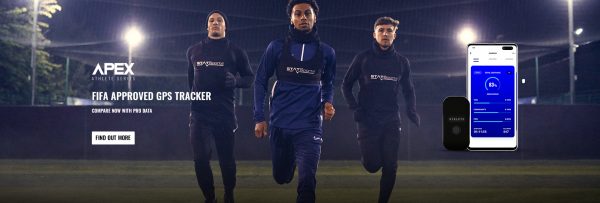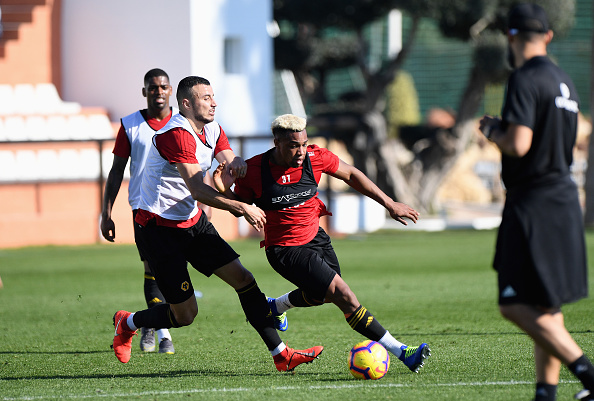
31 Mar Sprint Training – An Essential Tool For Injury Prevention
Introduction
Within team sports, injuries to players can significantly affect overall performance due to three main contributing factors.
Firstly, the absence of key contributors within a team will impede performance. Secondly, particularly with extended time-loss injuries where players are unable to train or perform to their full potential, they will inevitably experience performance decrements.
Finally, team cohesion and productivity intuitively decrease with player absence (1).
Within elite sports such as rugby, soccer and Australian rules, the lower limb injury incidence rate is very similar to the GAA sports of Gaelic football and hurling (2).
Lower limb muscle injuries such as hamstring, quadricep and calf strains, along with joint injuries to the groin, knee and ankle are the most prevalent within Gaelic football (76%) and hurling (68%).
60% percent of these injuries are non-contact and frequently occur during the actions of sprinting, jumping, landing, turning and kicking.
Specifically, hamstring strains contribute to over 50% of all muscle injuries in GAA, and 37% of muscle injuries in professional soccer (3).
The high prevalence level of non-contact muscle injury emphasises the need for an effective injury prevention strategy.
Need for Prevention
Due to the fact that a large proportion of muscle injuries in field-based sports occur during sprinting actions, sprinting is often blamed and viewed as the enemy.
This clear link often leads to an avoidance of max velocity sprinting within training despite sprinting being a key performance indicator in virtually all field-based sports (4).
Prevention strategies which primarily focus around strength are often utilised which frequently fail to replicate the unique action of sprinting due to a variety of reasons: their single joint approach, isolation of muscle groups, overall lower velocity profiles, and decreased range of motion (4).
With specific reference to hamstring injury, the commonly used resistance exercise, the Nordic curl, elicits only between 40-70% of the muscle activation observed when sprinting maximally and identifies the need for other means to be utilised within a training programme in order to strive to prevent injuries.
Due to reduction of muscle activation during resistance exercises in comparison to during sprinting, the potential exists for sprinting to act as a ‘vaccine’ for lower limb muscle injury (4, 5).
Benefits of Sprint Training
Consistent sprint training for all athletes is essential as when a significant difference exists between peak game and training velocities, the risk of injury becomes elevated.
It has been identified that players who reach ≥95% of their peak velocity in at least one effort per week are less likely to experience muscle injuries compared to those who reach ≤85% of their peak velocity (7).
Careful consideration must be used when developing a sprint training programme. The training should be overloaded progressively to allow players and athletes to adapt so that their ability to successfully meet the training demand is maintained.
Drastic increases in an athlete’s acute training load increases the chance of injury (7).
A weekly training load of ≥4750 AU reduced injury risk amongst elite Gaelic football players and they could effectively withstand a total weekly max velocity distance of between 90 to 150 metres compared to their counterparts with a weekly training load of ≤4750 AU (7).
A higher chronic training load has been found to add to player ‘robustness’.
A sprint-based injury prevention strategy can provide protection for the athlete due to the continuous exposure of high velocities whilst also eliciting sprint performance enhancements through developing a player’s max speed. Medical and performance staff should co-operate in the delivery of the programme.
Using the Apex Athlete Series Pod
The STATSports Apex Pod can be utilised to ensure accuracy in athlete sprint training progressions. The user’s ability to set a personalised ‘Sprint Entry Speed’ means that each athlete can ensure that they are completing a pre-determined number of sprint efforts in a session whilst monitoring the total distance covered at, or above, this speed.
In order to determine the athlete’s ‘Sprint Entry Speed’, a maximal speed test should be completed (Figure 1).
A ‘flying start’ or ‘acceleration zone’ is recommended to allow the player to increase speed gradually before completing a maximal effort. Generally, three efforts are advised with a full recovery between efforts to give the player the best chance of reaching their maximal velocity.

Figure 1 – Max speed test dimensions.
After completing the sprint efforts, the player’s max speed can be viewed using the ‘Live workout’ feature on the mobile app, or after the session on the ‘Recap’ tab (Figure 2:3).
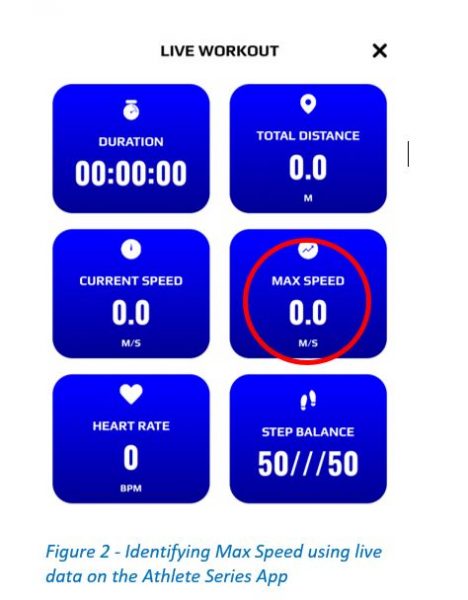
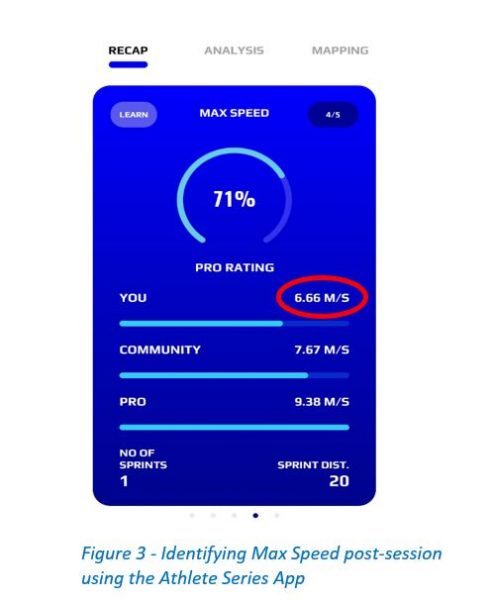
Following the identification of the player’s max speed, the correct sprint entry speed can be set individually on the player’s Apex Athlete Series App by selecting the ‘Configure Apex’ button.
Editing the ‘Sprint Entry Speed’ (Figure 4) to 95% of the player’s max speed will allow the athlete to track both the number of sprint efforts made and total sprint distance in subsequent sessions.

Figure 4 – Editing Sprint Entry Speed on the Athlete Series App
Recommendations
It has been identified that players with higher chronic training loads (over a 3 to 4 week period) have a heightened ability to tolerate the physical demands of their sport and their risk of injury is lower than their counter parts with lower chronic training loads.
Therefore, it is recommended to gradually increase the training load of a player throughout the season in line with the match demands of their sport. Training load will be affected by the status of the athlete as well as the duration and number of sessions completed each week.
Sprint training should also be progressive throughout the season to aid in player injury risk reduction. A maximum weekly overload in sprint distance of 50 metres is advised as this prevents any increase in injury risk due to an acute spike in load (7).
Total weekly exposures to maximal velocity should also be monitored with athletes being advised to achieve their maximal velocity (≥95%) approximately 8 times per week (Figure 5) in order to minimise the risk of muscle injury.
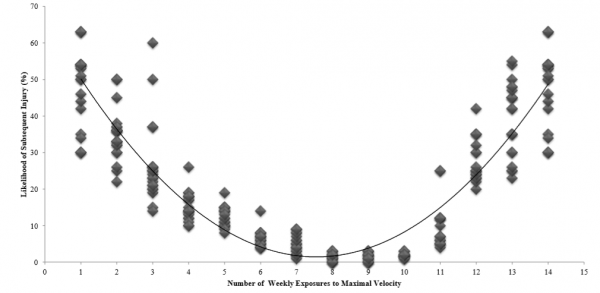
Figure 5 – Total number of weekly exposures and the link to injury incidence (8).
Additionally, recommended weekly total sprint distance will differ between sports. Elite soccer players being advised to complete between 201 – 350 metres at ≥95% of their max velocity, whilst elite Gaelic footballers have been advised to complete up to 150 metres at ≥95% of their max velocity (7, 8).
Sprint distance and efforts can be monitored throughout match play and training during the week and supplementary work can be added if a player is not achieving the targets.
Simple max speed drills similar to the aforementioned max speed test can be implemented to present the opportunity for players to achieve their max speed.
A ‘flying start’ is recommended to ensure that a player is at their maximal velocity for the duration of the targeted sprint distance.
Table 1 – Sample Weekly Sprint Training Program. Based on recommendations for a GAA team with a weekly overload of 20 metres in sprint distance with 8 efforts being completed per week.

*Does not account for any possible sprint efforts or distance observed in training or match play and these should be monitored.
Conclusion
The positive effects of players frequently achieving their maximum speed in both training and matches is evident.
The prevention of injuries and with it, the increase of player availability throughout a season will be of great benefit to any team.
Meanwhile increasing a player’s capacity to cope with increased physical demands of a match will also aid performance.
Furthermore, the continuous exposure of players to their maximal velocities may lead to development of their max speed which will only aid performance as increased speed may provide advantages in both attacking and defensive scenarios.
An appropriately structured and monitored training programme which caters for sprint training can be vital to a team’s success and coaches should strive to meet recommendations for their team’s sport and status.
References:
- Warnock, R., 2018. The Effect of Injuries on Player and Team Performance: An Empirical Analysis of the Production Function in the National Hockey League.
- O’Malley, E., Murphy, J.C., McCarthy Persson, U., Gissane, C. and Blake, C., 2017. The effects of the GAA 15 training program on neuromuscular outcomes in Gaelic football and hurling players; a randomized cluster trial. Journal of Strength & Conditioning Research, 31(8).
- Murphy, J. C., O’Malley, E., Gissane, C., & Blake, C., 2012. Incidence of Injury in Gaelic Football. The American Journal of Sports Medicine, 40(9), 2113–2120
- Edouard, P., Mendiguchia, J., Guex, K., Lahti, J., Samozino, P. and Morin, J.B., 2019. Sprinting: a potential vaccine for hamstring injury. Sport Performance & Science Reports, 48(1).
- Van Den Tillaar, R., Solheim, J.A.B. and Bencke, J., 2017. Comparison of hamstring muscle activation during high-speed running and various hamstring strengthening exercises. International Journal of Sports Physical Therapy, 12(5), p.718.
- Haugen, T., Seiler, S., Sandbakk, Ø. and Tønnessen, E., 2019. The training and development of elite sprint performance: an integration of scientific and best practice literature. Sports Medicine-Open, 5(1), p.44.
- Malone, S., Owen, A., Mendes, B., Hughes, B., Collins, K. and Gabbett, T.J., 2018. High-speed running and sprinting as an injury risk factor in soccer: Can well-developed physical qualities reduce the risk?. Journal of Science and Medicine in Sport, 21(3), pp.257-262.
- Malone, S., Roe, M., Doran, D.A., Gabbett, T.J. and Collins, K., 2017. High chronic training loads and exposure to bouts of maximal velocity running reduce injury risk in elite Gaelic football. Journal of Science and Medicine in Sport, 20(3), pp.250-254.
Author Details
Aaron Beattie
Graduate Sports Scientist l Sport Science Dept.
